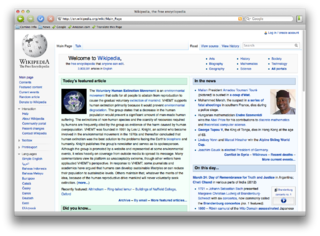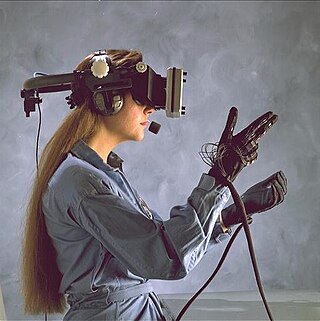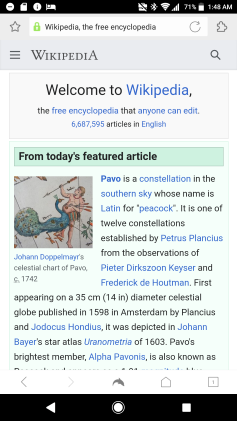Related Research Articles

Plan 9 from Bell Labs is a distributed operating system which originated from the Computing Science Research Center (CSRC) at Bell Labs in the mid-1980s and built on UNIX concepts first developed there in the late 1960s. Since 2000, Plan 9 has been free and open-source. The final official release was in early 2015.

Camino is a discontinued free, open source, GUI-based Web browser based on Mozilla's Gecko layout engine and specifically designed for the OS X operating system. In place of an XUL-based user interface used by most Mozilla-based applications, Camino used Mac-native Cocoa APIs. On May 30, 2013, the Camino Project announced that the browser is no longer being developed.

Haptic technology is technology that can create an experience of touch by applying forces, vibrations, or motions to the user. These technologies can be used to create virtual objects in a computer simulation, to control virtual objects, and to enhance remote control of machines and devices (telerobotics). Haptic devices may incorporate tactile sensors that measure forces exerted by the user on the interface. The word haptic, from the Greek: ἁπτικός (haptikos), means "tactile, pertaining to the sense of touch". Simple haptic devices are common in the form of game controllers, joysticks, and steering wheels.

A tangible user interface (TUI) is a user interface in which a person interacts with digital information through the physical environment. The initial name was Graspable User Interface, which is no longer used. The purpose of TUI development is to empower collaboration, learning, and design by giving physical forms to digital information, thus taking advantage of the human ability to grasp and manipulate physical objects and materials.

BumpTop was a 3D desktop environment that simulates the normal behavior and physical properties of a real-world desk and enhances it with automatic tools to organize its contents. It is aimed at stylus interaction, making it more suitable for tablet computers and handheld PCs. It was created at the University of Toronto as Anand Agarawala's master's thesis. Agarawala also gave a presentation at the TED conference about his idea. The 1.0 version was released on April 8, 2009, along with a fully featured pro version as a paid upgrade. On April 30, 2010 the author announced that BumpTop was being discontinued and that they were taking the software "in an exciting new direction." Two days later, it was announced that the company had been acquired by Google. On January 5, 2011, Google released a sneak preview video of Android 3.0 Honeycomb showing a 3D desktop with features purportedly taken from BumpTop.
Opera Mobile is a mobile web browser for smartphones, tablets and PDAs developed by Opera.

In computing, multi-touch is technology that enables a surface to recognize the presence of more than one point of contact with the surface at the same time. The origins of multitouch began at CERN, MIT, University of Toronto, Carnegie Mellon University and Bell Labs in the 1970s. CERN started using multi-touch screens as early as 1976 for the controls of the Super Proton Synchrotron. Capacitive multi-touch displays were popularized by Apple's iPhone in 2007. Plural-point awareness may be used to implement additional functionality, such as pinch to zoom or to activate certain subroutines attached to predefined gestures.
Perceptive Pixel is a division of Microsoft specializing in research, development and production of multi-touch interfaces. Its technology is used in fields including broadcast, defense, geo-intelligence, energy exploration, industrial design and medical imaging.
Microsoft PixelSense was an interactive surface computing platform that allowed one or more people to use and touch real-world objects, and share digital content at the same time. The PixelSense platform consists of software and hardware products that combine vision based multitouch PC hardware, 360-degree multiuser application design, and Windows software to create a natural user interface (NUI).
In computing, a natural user interface (NUI) or natural interface is a user interface that is effectively invisible, and remains invisible as the user continuously learns increasingly complex interactions. The word "natural" is used because most computer interfaces use artificial control devices whose operation has to be learned. Examples include voice assistants, such as Alexa and Siri, touch and multitouch interactions on today's mobile phones and tablets, but also touch interfaces invisibly integrated into the textiles furnitures.

The Dolphin Browser is a web browser for the Android and iOS operating systems developed by MoboTap Inc. It was one of the first alternative browsers for the Android platform that introduced support for multi-touch gestures. Dolphin Browser uses its native platform's default browser engine.

xombrero is a discontinued open-source web browser developed with a goal to be a lightweight and secure replacement for full featured browsers like Firefox. The browser has found a niche among minimalist browsers for heavy keyboard users by balancing minimalism with usability.

Nortd Labs a.k.a. NOR_/D is an international research and development collaborative dedicated to the merging of open source art, architecture, software and system design. NORTD Labs is also a studio of creative thought that engages science, art and design.
Stefan Hechenberger is an Austrian artist and programmer. His works include interactive software, computer vision projects and open-source hardware.

RStudio is an integrated development environment for R, a programming language for statistical computing and graphics. It is available in two formats: RStudio Desktop is a regular desktop application while RStudio Server runs on a remote server and allows accessing RStudio using a web browser.
The Human Media Lab(HML) is a research laboratory in Human-Computer Interaction at Queen's University's School of Computing in Kingston, Ontario. Its goals are to advance user interface design by creating and empirically evaluating disruptive new user interface technologies, and educate graduate students in this process. The Human Media Lab was founded in 2000 by Prof. Roel Vertegaal and employs an average of 12 graduate students.

Addie Wagenknecht is an American artist and researcher living in New York City and Liechtenstein. Her work deals primarily with pop culture, feminist theory, new media and open source software and hardware. She frequently works in collectives, which have included Nortd Labs, F.A.T. lab, and Deep Lab. She has received fellowships and residencies from Eyebeam, Mozilla, The Studio for Creative Inquiry at Carnegie Mellon University and CERN.

GameFace Labs is an American technology company that develops hardware and software for the consumer virtual reality market, and was founded in 2013 by Edward Mason. The company's headquarters are in San Francisco, with international offices in London, United Kingdom.

QQ Browser is a web browser developed by Mainland Chinese technology company Tencent. It utilizes two browser engines: WebKit and Trident. Previously, Tencent had developed Tencent Explorer and Tencent TT, two browsers based on the Trident engine, as well as QQ Browser versions 5 and 6, which integrated the WebKit engine.
References
- 1 2 Greene, Kate (2008-05-01). "Open-Source, Multitouch Display". MIT Technology Review. Cambridge, Massachusetts. Retrieved 7 February 2017.
- ↑ "Home invention". The Economist. 2008-05-01.
- ↑ Saffer, Dan (2008-11-20). Designing Gestural Interfaces. O'Reilly Media, Inc. pp. 128–. ISBN 9780596554224 . Retrieved 27 February 2013.
- ↑ "Nortd Labs". Archived from the original on 2017-02-11. Retrieved 2017-02-07.
- ↑ O'brien, Will (2008-07-08). "IR multitouch screen" . Retrieved 2008-07-14.